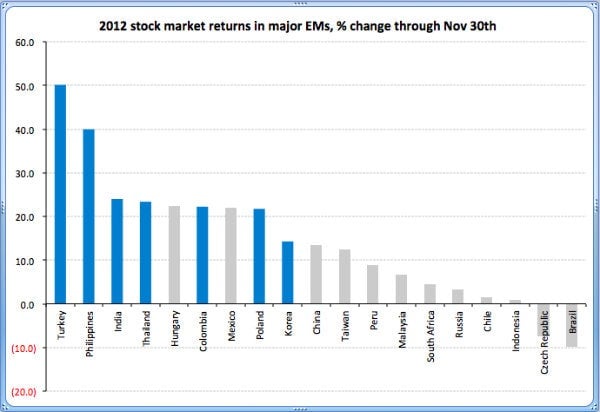If you want stock market returns, forget the BRICs—these are the countries to look at
A new phase of emerging market investing, “The Third Coming,” is now truly upon us. The first was a dizzying period of discovery from the late 1980s to the early 1990s and the second came in the great boom of the mid-2000s when it seemed all emerging markets were taking off together, fueling extraordinary returns. But that era ended in 2010. Since then, as the global economy slowed, the easy money dried up, and blue-sky optimism faded, the Third Coming has looked likely to be an era marked by moderate and uneven growth in developing economies, with new stars rising to the top and a breakup of herd behavior in the markets.


A new phase of emerging market investing, “The Third Coming,” is now truly upon us. The first was a dizzying period of discovery from the late 1980s to the early 1990s and the second came in the great boom of the mid-2000s when it seemed all emerging markets were taking off together, fueling extraordinary returns. But that era ended in 2010. Since then, as the global economy slowed, the easy money dried up, and blue-sky optimism faded, the Third Coming has looked likely to be an era marked by moderate and uneven growth in developing economies, with new stars rising to the top and a breakup of herd behavior in the markets.
The first 11 months of 2012 followed this scenario exactly, with emerging-market (EM) stocks up 10% and the gap between the best and worst performing major emerging markets widening to 60 points, up from a ridiculously low level of 10 points in the first half of 2011. More interestingly, compared to the splashy economic stars of the last decade, captured in that mindless acronym BRICS, the new winners are like monks in the marketplace, quiet figures cloaked under drab robes, concealing an enlightened spirit inside.

Here are quick profiles of emerging nations that both rank among the top performers this year, and are on track to be breakout nations:
Turkey, the Muslim model. After overheating in 2011, the economy is slowing to a sustainable pace. Prime Minister Recip Tayyip Erdogan is inspiring struggling Muslim nations to believe they can achieve economic success, too. He pushed economic orthodoxy to tame inflation, and opened office doors to pious Muslims who had been shut out of plum jobs by the previous regimes. In a pious Muslim country, this was tantamount to welcoming the majority into the mainstream, and Turkey has prospered ever since.
The Philippines, a former star in recovery. The Philippines lagged for so long—it now has a per capita income of barely $2,500 and a chance to start over from a low base. Since taking office in 2010, President Noynoy Aquino has shown the competence his nation needs to restore some of the luster of the Philippines of half a century ago. Now, there are even signs of a manufacturing comeback. Like many economies in the region, the Philippines is gaining from rising wages in China and the appreciation of the yuan. Further, the nation’s huge wealth in natural resources is still largely untapped. If the Aquino government gets down to laying out a policy framework to tap that wealth, then it could be another major driver of growth along with the continuing boom in the business process outsourcing field.
Thailand, where politics is the key. Though Prime Minister Yingluck Shinawatra continues to champion subsidies for rural voters, as her brother Thaksin did before her, she is also pushing macro reform. While many peers struggle with high debts, expensive currencies and uncompetitive wages, Thailand has none of the above. Export growth has amassed a $180 billion reserve, which Shinawatra is investing in productive ways, including new logistics systems. The wildcard: can she contain the tensions between city and countryside that exploded under Thaksin?
India, the only BRIC beating the EM average. India is bouncing back from a weak 2011. Despite the falling GDP forecasts, 5-6% growth isn’t bad for a country with a per capita income of $1,500. With its back to the wall, the government recently cut fuel subsidies and opened up to foreign retailers, helping to arrest the decline in growth expectations. Foreign investors cling to the belief that, for a nation this poor and yet with increased dynamism of its states, there is an inertial rate of growth of at least five%.
Poland, in Europe’s sweet spot. This is the period after a country has reformed its financial institutions in order to enter the EU, and is working to contain budget and trade deficits to meet the requirements of the euro zone. At this stage, Poland is a stable magnet for investment, and suffers none of the instability that hit the likes of Greece and Ireland after they actually adopted the euro. A model reformer, Poland recently raised its retirement age to 67, at a time when other Europeans are protesting for the right to retire in their 50s.
Colombia, an amazing turnaround. Colombia has a long democratic tradition, but was overrun by drug traffickers and left-wing guerrillas in the 1990s. Under tough new leaders, it has contained the criminals and the rebels, and begun to emulate the moderate reforms that made Chile the richest nation in the region. With a surprisingly diverse economy, Colombia is gaining traction.
South Korea, the manufacturing barrier-buster. Ever resilient, South Korea has again held up despite slowing global demand for the manufactured exports that drive its economy. Along with Taiwan, South Korea is the only economy that ever managed to sustain growth at a pace above 5% for five decades, and now it is poised to graduate into the developed class of nations, alone. Taiwan continues to assemble electronics for global brands, while South Korea is the first emerging nation to produce its own global brands. It has one of the most diversified export baskets in the developing world as it continues to gain global market share in a whole range of sectors from automobiles to shipbuilding and handsets.
Nigeria, one of the best performing frontier markets, is up nearly 40%. In a nation plagued for years by corrupt presidents, Goodluck Jonathan brought integrity and basic reform, mobilizing investment in agriculture, oil and gas, and power. Nigeria generates as much electricity as some small towns in England, making it a costly place to do business. But obvious flaws can leave a poor country plenty of room to grow from a low base. Nigeria has a per capita income below $1,500, and a good leader with many easy targets for reform.